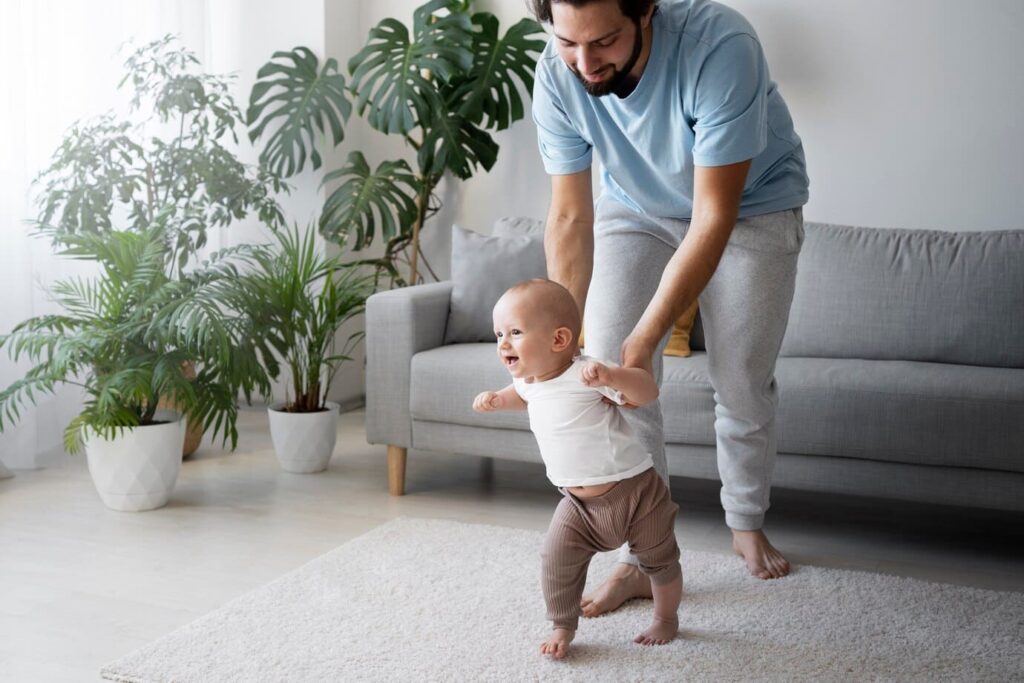As parents, we want to give our babies the best possible start in life. We celebrate each developmental milestone with joy and pride. Seeing your little one pull up to stand for the first time is certainly an exciting moment!
But is it bad to hold baby in standing position? There has been some debate around this practice.
While the standing position can have developmental benefits, many experts warn that it does carry risks if not done properly. In this article, we’ll take a comprehensive look at the potential pros and cons, safety precautions, and what the research says about age-appropriate guidelines.
When and Why Parents Use the Standing Position
Many loving parents start holding their babies upright because they want them to see the world from an engaged, upright view. It feels more interactive for the baby and allows them to observe their surroundings.
Others believe holding babies upright aids their physical development by allowing them to bear weight on their legs and builds strength that will later help with standing and walking skills. It engages the leg and core muscles which are vital for mobility.
Additionally, some babies simply seem to enjoy a change of position and perspective. The standing position can have a soothing effect for fussy babies.
So while the intent is positive, we have to look carefully at both sides of this debate.

The Potential Benefits of Using the Standing Position
- Enhanced Visual and Social Development: Seeing the world upright allows babies to start visually mapping their surroundings and understand distances better. It can aid visual tracking skills and hand-eye coordination. The different view facilitates more face-to-face social interaction as well.
- Leg Muscle Engagement: Having to bear some weight on the legs encourages leg muscles to strengthen in preparation for hitting physical milestones like standing, cruising, and walking down the road. It facilitates weight shifting as well.
- Calming Impact: Some babies find a change of scenery and position to be soothing. This allows them to calmly observe their surroundings.
So in moderation, under the right circumstances, the standing position can have some developmental upsides. But there are also important health risks to consider.
The Dangers and Risks of the Standing Position
While the standing position might have some benefits, it does come with hazards if not done with caution:
- Hip Dysplasia: Holding infants upright too early or too frequently can put a strain on joints that are still developing. This stress can contribute to conditions like hip dysplasia.
- Lack of Head/Neck Support: Babies initially have poor head and neck control. The standing position makes it harder to properly support these areas.
- Monitoring Cues: When held facing away, it can be trickier to monitor an infant’s signals and facial cues. Subtle signs of distress may be missed.
- Higher Fall Risk: There is always an increased risk of slips or accidents when babies are held upright without proper leg strength. A fall could lead to a serious injury.
- Limiting Movement: The standing position restricts an infant’s natural movements and responses. This could inhibit the intuitive motor learning process.
So while the standing position seems innocent enough, these hazards are important to keep in mind. There are proper precautions parents can take to reduce the risks.
Safety Precautions When Using the Standing Position
If after considering the pros and cons, you sometimes use the standing position, make sure to follow these safety guidelines:
- Always maintain support under the baby’s bottom, core torso, back, and neck. Never dangle baby upright without complete support.
- Limit the time the baby spends in the upright position, especially in the early months. Start with just 1-2 minutes.
- Closely monitor the baby’s signals – facial cues, body language, and cries. Stop immediately if they indicate any discomfort or distress.
- Ensure proper alignment of baby’s hips, knees, neck and back. Don’t let your legs simply dangle without support.
- Upgrade baby gear as needed for adequate back & neck support during upright holding.
Following these rules will help minimize the risks of the standing position. But what do health organizations say about age appropriateness?
Age-Appropriate Guidelines for the Standing Position
Reputable pediatric sources offer caution when it comes to holding infants upright, especially newborns:
- Not Recommended for Newborns: In the first months, babies lack adequate muscle strength and development to be upright. Time in this position should be extremely minimal.
- Brief Holding Can Start Around 6 Months: After developmental progress like neck control and core strength have improved, very brief assisted standing can be cautiously introduced starting around 6 months.
- Increase Slowly After Milestones Met: Only increase the frequency/duration of assisted standing incrementally between 9-12 months as the baby shows readiness by meeting motor milestones like sitting independently.
The exact timeline will vary for each child. Close communication with the baby’s pediatrician is advised. But are there times when extra caution is warranted?
When to Ask Your Pediatrician Before Trying
For some infants, extra care should be taken around introducing upright supported standing:
- Babies born prematurely
- Birth defects like muscular issues or hip dysplasia
- Hypotonia (low muscle tone) or hypermobility
- Family history of orthopedic issues
If your baby falls into any of these categories, chat with your pediatrician first before trying assisted standing. They can help assess if it’s appropriate or modifiable based on your child’s needs.

Milestones and Skills That Build Up to Standing
Since the standing position can be risky in younger babies, what can parents do to encourage developmental progress that will make standing safer in the future?
Laying the right foundation in earlier months is key. Here is an overview of beneficial activities:
Newborn Leg Kicking
Even as newborns, babies instinctively kick their legs frequently when lying on their backs. Encouraging this natural movement helps build leg strength from day one.
Tummy Time for Core Muscles
Little bursts of tummy time help babies strengthen their neck, back, and core muscles which are all vital for later mobility. Intersperse short periods of supervised tummy time throughout awake periods.
As babies hit motor milestones like rolling (3-4 months), sitting assisted (6 months) then independently (7-9 months), and crawling (8-10 months), continue providing plenty of tummy time and floor play which builds total body coordination.
Mastering these prerequisites ensures your baby has developed the foundation to start bearing weight on their legs and building towards standing upright.
Developmentally-Appropriate Toys for Building Strength
While fancy developmental toys and baby gyms have their place, parents can utilize simple household items to encourage their baby’s physical progress:
- Rolled towels or blankets – These help slightly prop babies working on rolling or sitting skills.
- Low surfaces & couches – Pulling up is aided by starting on low, sturdy surfaces before progressing to higher ones like crib rails.
- Cardboard boxes – Open empty boxes make great toddler activity centers for play or even taking early steps while holding the rim.
Being creative with common household items provides babies with opportunities to build physical skills without overusing restrictive baby gear.
How Parents Can Help Baby Progress to Standing
Beyond tummy time in the early months, how else can parents facilitate progress towards standing upright?
- Continue providing plenty of supervised floor time for free movement and motor skill development through the crawling stage.
- Around 6-9 months, help bear some of the baby’s weight while they stand and bounce supported on your lap. Monitor for signs of fatigue.
- Sing songs and play standing games while supporting the baby upright to make it engaging.
- Demonstrate standing, cruising, and walking skills for them to observe and incentive reaching the next stages.
- Childproof home for safety once pulling up and cruising begin!
With patience and by following the baby’s cues, you can nurture progress towards standing safely.
An Overview of Key Standing Milestones
Now that we’ve covered a lot of ground about the use of upright standing with babies, let’s do a quick review of the timeline for this skill:
- 3-5 months – Bears some weight on legs when supported in a standing position
- 6-9 months – Stands supporting most weight while held upright
- 9-12 months – Pulls up to stand holding onto furniture
- 12-15 months – Stands independently for short periods
- 15-18 months – Stands, squats, and plays while standing unassisted
Remember each baby progresses differently! If you have any concerns about your child’s development, talk to their pediatrician or seek an evaluation from early intervention specialists.
Conclusion – Standing Can Be Positive If Done Carefully
In the end, when done carefully and age-appropriately, allowing babies to bear weight on their legs and incorporate upright standing into play can have developmental benefits. It introduces important skills that lay the foundation for future milestones.
However, due to potential health risks, extra caution is warranted. Standing unsupported or for prolonged periods is not recommended, especially in infancy. Parents should provide plenty of floor time and only integrate brief, assisted standing play once the baby has mastered other key milestones first.
Following pediatric guidelines, paying close attention to the baby’s cues and development, not overusing restrictive gear, and taking proper safety precautions allows parents to nurture progress while avoiding potential harm.
As with any parenting decision, you know your child best. Trust your intuition, lean on your pediatrician’s expertise, and enjoy celebrating each new milestone when your baby is ready!
FAQs – Is it bad to hold baby in standing position?
Is holding my baby upright bad for their development?
Holding babies upright can have benefits but also risks. Limited, supervised upright holding can help strengthen muscles and allow babies to view the world interactively. But frequent or unsupported standing may put strain on still-developing joints. Every baby develops differently, so discuss guidelines with your pediatrician.
What are the benefits of holding my baby in a standing position?
Potential benefits include building leg strength to aid milestones like standing/walking, enhanced visual mapping skills, and more face-to-face social interaction. Some babies find the upright position engaging and soothing as well.
At what age is it safe to hold my infant upright?
Experts caution against upright holding especially in newborns and young infants. Around 6 months old, very brief assisted standing can be introduced once babies have hit strength milestones like neck/trunk control and sitting upright. Increase cautiously as they develop further motor skills.
is it bad to hold baby in standing position ? Are there any risks?
Yes, possible risks include strained joint development, lack of neck/head support, difficulty monitoring cues, increased falling hazard, and restricting natural movement patterns. Hip dysplasia is also a concern if upright positioning is frequent or weight is placed on dangling legs.
How can I hold my baby upright safely?
If practicing cautiously supported standing, always support the baby’s bottom/back, limit time upright, pay close attention to signals, ensure proper alignment, and stop immediately if they show any sign of discomfort or distress. Make sure to consult your pediatrician about appropriateness for your baby.











